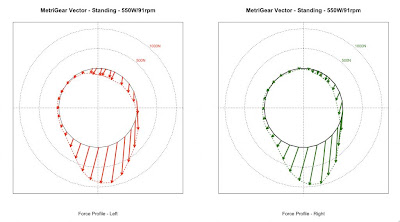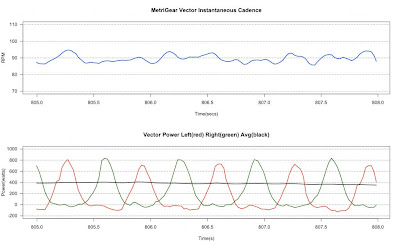Metrigear has been testing their Vector power meter for sometime now and technicians are regularly posting test data on their blog. These folks are taking a physicists approach to giving you pedaling data by getting right down to the finer details, such as the direction of pedal force vectors. The sensors on this system are sealed inside the pedal spindle and the system collects data at a claimed half a million cycles per second.
A vector is something that signifies both magnitude and direction of a quantity. Only certain quantities can be vectors. Speed is not a vector, but velocity is. Why? Here's a tricky one. Is time a vector or scalar?
Below are images of leg force vectors from two cyclists (borrowed from the Metrigear blog). Both are standing on the pedals, with Cyclist A applying 460 watts of power to the pedals at 77 RPM and Cyclist B applying 550 watts at 91 RPM. Red vector lines belong to the left leg, while green belongs to the right leg.
The recent blog post in which they uploaded all this information into was curiously titled "Is Your Pedal Force As Unique As Your Fingerprint?".
Some of you may think that it warrants looking at many different snapshots of leg force over a power spectrum. To me, the question is not a logical one. Comparing the nature of pedaling, which is highly variable, to genetically determined ridges on your skin is a little absurd.
Wouldn't you think that pedaling signatures for just one person alone could be different from day to day. Suppose one had a heavy breakfast, or wore a backpack or decided to shift a bit forward while biking, vectors could change pretty noticeably, wouldn't you agree?
For some, these sort of 'precision' measurements can take the life out of cycling and is an unnecessary luxury. For others, its a novel way to spend more money to enable them some more understanding of what they want to do.
I personally think average pedaling power and cadence is what is ultimately more relevant compared to instantaneous variations here and there in the pedaling 'clock' diagram. Unless one side is really off balance, which you would be able to tell without any instruments, I don't know how practical all these beans would be.
Anyone with a basic understanding of periodic waves will have a feel for the fact that to produce a constant power of so many watts, each individual leg will need to produce little over twice that amount. The average value of a pure half sine wave is 0.637 times the peak. Some deviation from the ideal "springy" waves is seen because of the variable output from human power, like in the image below.
The fact that each leg enters its power phase when the other is resting is one of the beautiful things of bicycle design. Perhaps this design was a natural step in its evolution after all that running Karl Drais did across the countryside with his 'hobby horse'. Bicycling in one way is an evolution of basic locomotive movements. Its value lies in the fact that, save for a few extreme terrain conditions, you can use gears, ball bearings and a pair of wheels to easily amplify this motion 10, 50, even 100 times.
Anyway, let's go back to Metrigear. Are you the type of person who thinks all this bean counting isn't really necessary? Or are you the one who always feels you're on the short side of data and you hunger for more, knowing you'll pay for it of course ?







Maybe there are two types of cyclists. Those who like the details and those who just get out there and ride. Radical differentiation is, supposedly, the way to enlightened brand building and Metrigear's angle is the physics.It's probably a zag as Neumeier would put it, and is a hook for the riders who like the details. Bike snob NYC's recent post had a dig at Reynold's "Swirl Lip Generator" technology inspired new carbon wheelset--pay $6000 or $600 for something that practically does as good a job. Personally I'm happy with good gear that goes the distance with minimum problems.
ReplyDeletePerhaps for a constant seated effort like a time trial, there maybe a signature. But it'd be interesting to see how much of a change is brought about by changes in frame geometry, seating positions etc.
ReplyDeleteEven though I have no particular need for it, I love the concept of capturing as much data as possible. I imagine that if you fed enough data into an expert system, it could probably pinpoint what your optimal cadences are, when you tend to slack off, when you need to back off, and that sort of thing.
ReplyDeleteI don't think the analytical piece of the puzzle exists yet, but it's interesting that a lot of Cat 4s can afford the equipment to capture just about every possible piece of information.
This is some very resourceful information by the way. I wonder if lance armstrong ever applies these theories or maybe his trainer uses these studies to help him out when he used to cycling.
ReplyDeletephone number lookup